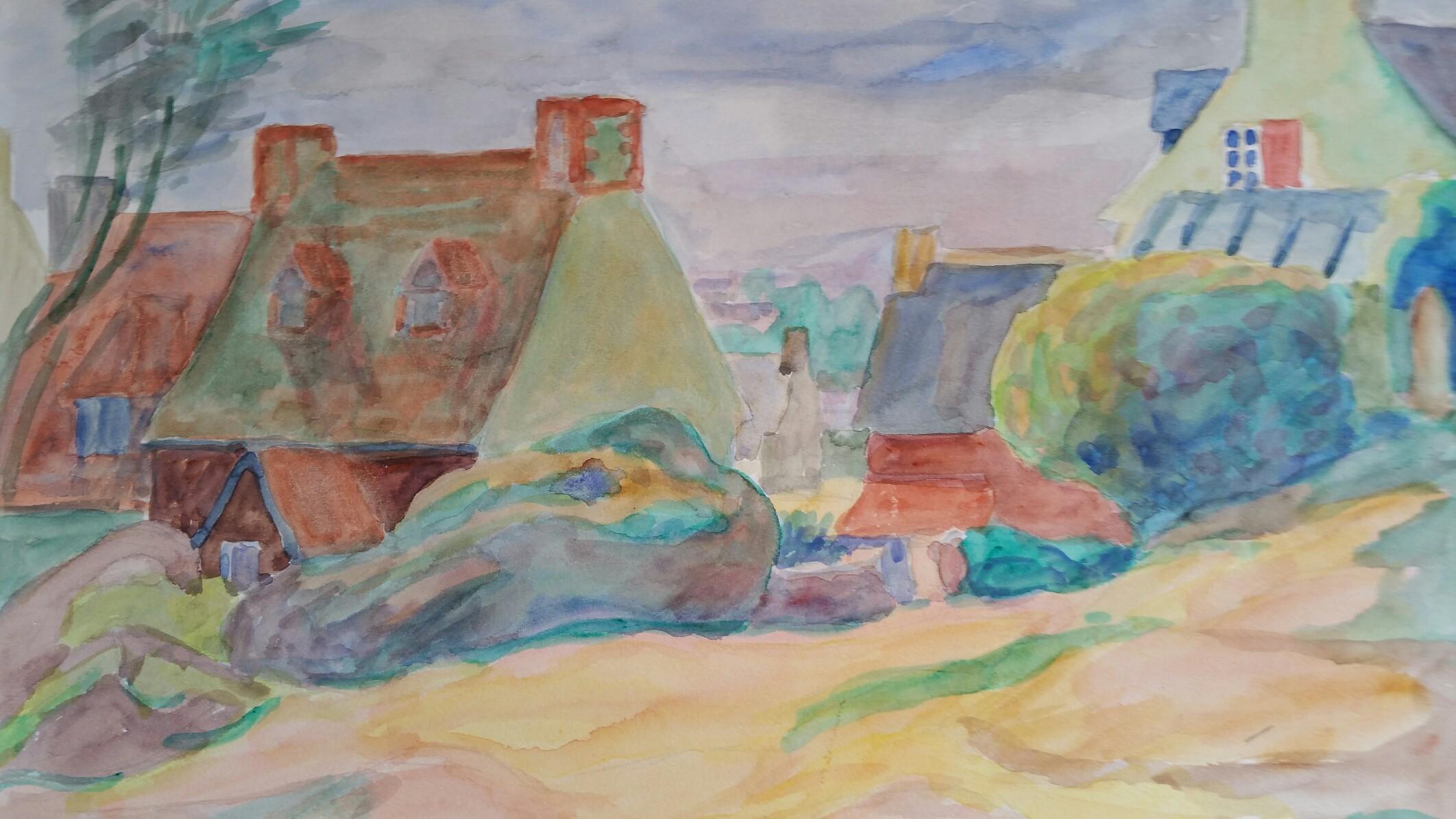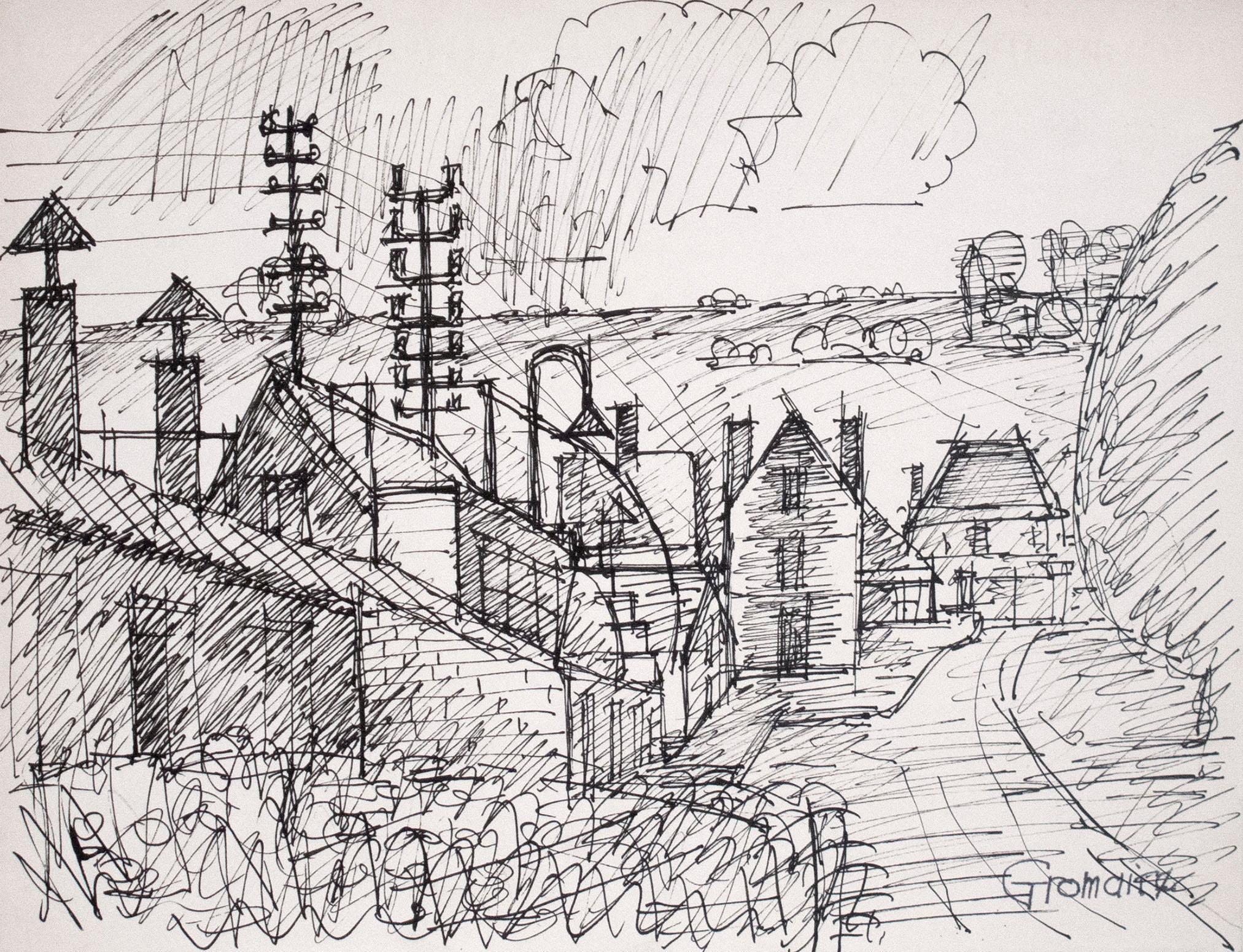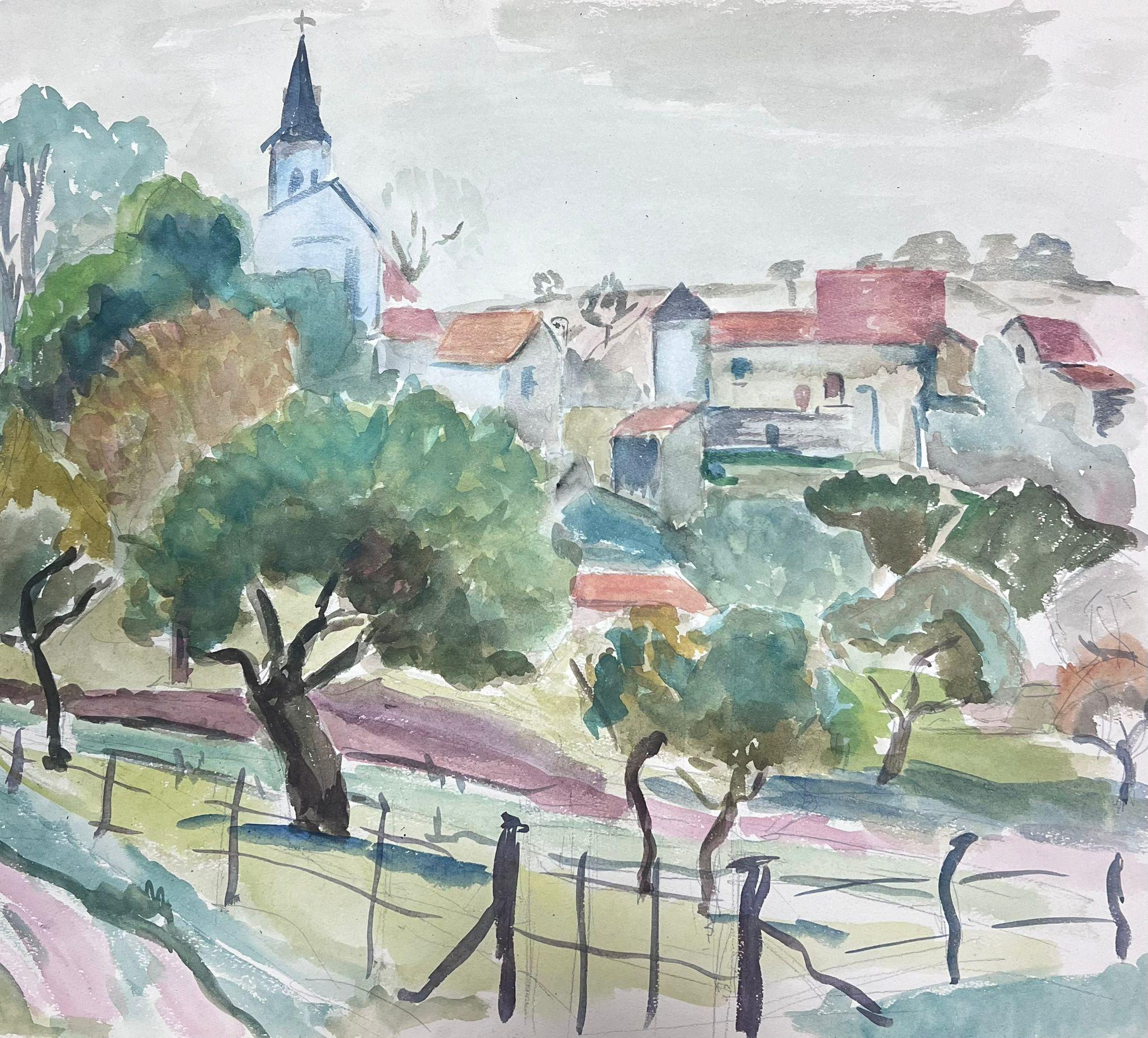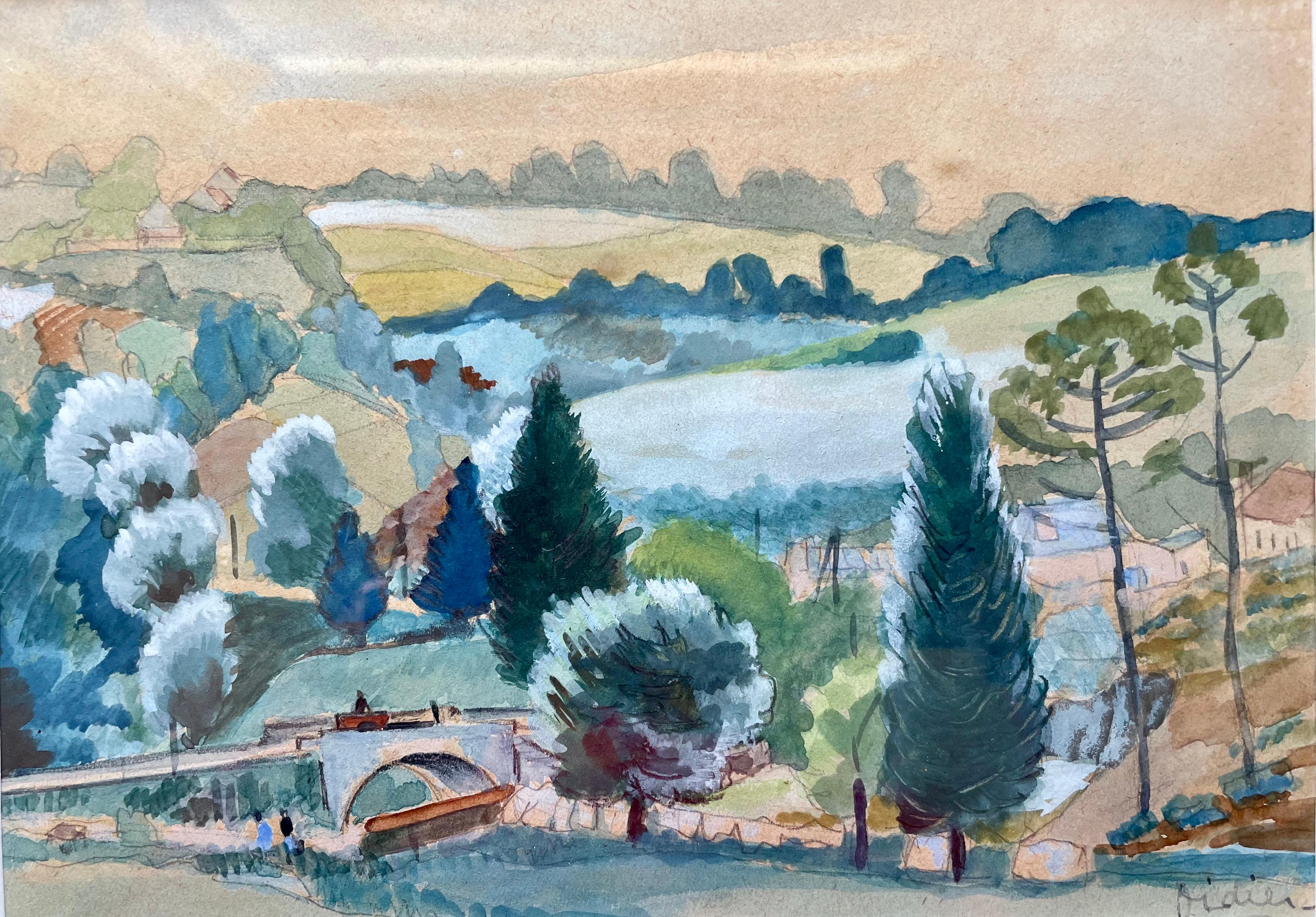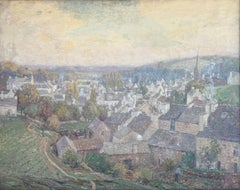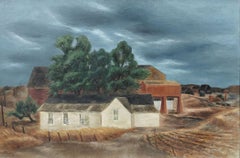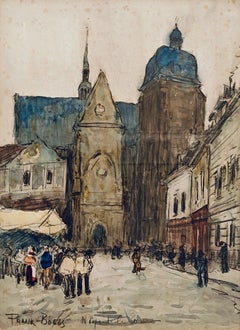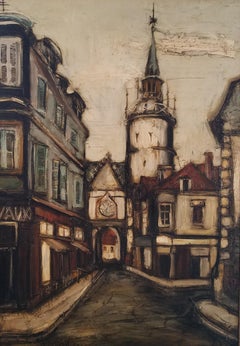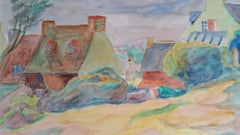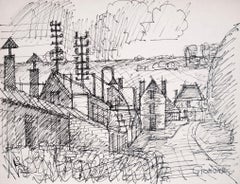Items Similar to "Suburb of Gif-sur-Yvette, France" Henry Yuzuru Sugimoto, Modernist Landscape
Want more images or videos?
Request additional images or videos from the seller
1 of 9
Henry Yuzuru Sugimoto"Suburb of Gif-sur-Yvette, France" Henry Yuzuru Sugimoto, Modernist Landscape1928-1932
1928-1932
$6,000
£4,552.66
€5,205.56
CA$8,380.37
A$9,317.83
CHF 4,865.26
MX$113,420.74
NOK 62,078.59
SEK 58,164.67
DKK 38,850.07
Shipping
Retrieving quote...The 1stDibs Promise:
Authenticity Guarantee,
Money-Back Guarantee,
24-Hour Cancellation
About the Item
Henry Yuzuru Sugimoto
Suburb of Gif-sur-Yvette, France, circa 1928-32
Signed lower left
Watercolor on paper
11 x 14 inches
Henry Sugimoto was born in Wakayama, Japan, on March 12, 1900. His father left for the United States shortly after he was born, and his mother joined him some years later, with the result that the young Henry was raised largely by his grandparents. Following the end of World War I, Henry Sugimoto arrived in the United States as a "yobiyose" (child brought over) and settled with his parents in Hanford, California. After attending Hanford High School, he enrolled at the University of California, Berkeley. He soon grew absorbed in art and his parents agreed to let him enroll at the California School of Arts and Crafts. After studying there for four years with a concentration in oil painting, he graduated with honors in 1928. He then moved to the California School for Fine Arts, but after a year there he decided to travel to France, the international artistic capital, for further study. Once arrived in Paris, Sugimoto became close to the circle of Japanese artists there. While he initially took up study at the Académie Colarossi in Paris, after a painting of his was rejected for inclusion by the prestigious Salon d'Automne he quit the Académie and took up residence in the French countryside. One of his landscape paintings was accepted for the 1931 Salon d'Automne.
Sugimoto returned to California in 1932 with a vastly increased reputation. He was granted a solo exhibition at San Francisco's Legion of Honor Museum in 1933. His French paintings, colorful and sensual canvases heavily influenced by Cezanne and French post-Impressionists, received such favorable notices that the show was expanded in size and its run extended. Over the years that followed, Sugimoto continued to paint and to exhibit his works in group shows in San Francisco. After two years living in the Bay Area, he married Susie Tagawa in 1934 and moved back to Hanford, where he worked as a laundry worker and part-time art teacher. During these years, he made several trips to Yosemite National Park, which inspired large-size landscapes. In 1939 he spent a month in Mexico, where he was decisively influenced by the social realist art of famed muralist Diego Rivera.
Following the issuing of Executive Order 9066 , the Sugimoto family was rounded up in Spring 1942 by the army and confined in Fresno Assembly Center . They were then sent on to the Jerome camp in Arkansas, moving to the Rohwer camp in June 1944 when Jerome closed its doors. Sugimoto was shocked by the government's treatment. Believing it was his mission as an artist to document and protest his experience, Sugimoto began painting scenes of daily life. Because traditional art materials were hard to acquire, he painted on sheets, pillowcases, and canvas mattress covers. At first, fearing confiscation of his works by the authorities, Sugimoto concealed his paintings. However, he was encouraged by camp administrators, who even used him in a pro- WRA propaganda film. He thereafter began painting openly, and was hired to teach painting classes at Jerome High School. Eventually, Sugimoto compiled approximately 100 oil paintings, watercolors, and sketches. The paintings refer in pointed fashion to the injustice and irony of locking up loyal Americans. For example, the mural "Protecting our Flag" depicts a troupe of Nisei Boy Scouts guarding an American flag from seizure by a mob enraged by the shooting of an inmate. "Nisei Babies in Concentration Camp" portrays a room full of infants surrounded by barbed wire and armed guard patrols. Sugimoto also heavily dramatized the inmates' patriotism, most notably through scenes of Nisei soldiers leaving camp. In February 1944, once more with the approval of WRA authorities, he organized a show of his camp paintings at nearby Hendrix College in Conway, Arkansas.
In 1945, Sugimoto was able to leave camp. He was near penniless. The mass of 100 prewar paintings that he had stored in San Francisco had been sold at auction during the war, and he was unable to recover the proceeds. He relocated to New York City, whose artistic climate he had always admired. There, in addition to painting, he was employed part-time as a textile designer. He also worked as a book artist. In 1949, he produced the illustrations for Songs From the Land of Dawn , by the Japanese Christian reformer Toyohiko Kagawa. Two years later, he provided the artwork for New Friends for Susan , a children's book by Nisei writer Yoshiko Uchida about a Japanese American girl. He continued to show his work in various venues. In 1960, he took part in a show of the Society of Washington Printmakers at the Smithsonian Institution. In mid-1962, a set of Sugimoto's paintings was exhibited at the Galerie Internationale in New York, his first solo show in nearly two decades. Unfortunately a newspaper strike broke out as it opened, and the show failed to attract significant publicity or sales. Another show three years later at the same gallery, even with newspapers in operation, did not do noticeably better. Sugimoto held a further show of new works at the Wiener Gallery in New York in May 1974.
The ongoing rediscovery and celebration of Sugimoto's oeuvre climaxed in 2000 with a major exhibition of his works at the Japanese American National Museum in Los Angeles, where his personal art collection had been donated by his family. Due in part to positive reviews by the Los Angeles Times and New York Times , the exhibition was a smash hit and was extended due to its popularity. In connection with the exhibition, a documentary, Harsh Canvas , and a book, Henry Sugimoto: Painting an American Experience , both appeared. Sugimoto's art has entered the collections of the Smithsonian Institution, and his creations have been featured on covers of numerous books about wartime Japanese Americans.
- Creator:Henry Yuzuru Sugimoto (1900 - 1990, Japanese)
- Creation Year:1928-1932
- Dimensions:Height: 18 in (45.72 cm)Width: 21 in (53.34 cm)
- More Editions & Sizes:Unique WorkPrice: $6,000
- Medium:
- Movement & Style:
- Period:
- Condition:
- Gallery Location:New York, NY
- Reference Number:1stDibs: LU1841215406982
About the Seller
5.0
Platinum Seller
Premium sellers with a 4.7+ rating and 24-hour response times
Established in 2022
1stDibs seller since 2022
115 sales on 1stDibs
Typical response time: <1 hour
- ShippingRetrieving quote...Shipping from: New York, NY
- Return Policy
Authenticity Guarantee
In the unlikely event there’s an issue with an item’s authenticity, contact us within 1 year for a full refund. DetailsMoney-Back Guarantee
If your item is not as described, is damaged in transit, or does not arrive, contact us within 7 days for a full refund. Details24-Hour Cancellation
You have a 24-hour grace period in which to reconsider your purchase, with no questions asked.Vetted Professional Sellers
Our world-class sellers must adhere to strict standards for service and quality, maintaining the integrity of our listings.Price-Match Guarantee
If you find that a seller listed the same item for a lower price elsewhere, we’ll match it.Trusted Global Delivery
Our best-in-class carrier network provides specialized shipping options worldwide, including custom delivery.More From This Seller
View All"French Landscape" Wilson Irvine, American Impressionist Rural French Town
Located in New York, NY
Wilson Irvine
French Landscape, circa 1908
Signed lower right
Oil on canvas
29 x 36 inches
A prolific Impressionist with a penchant for atmospheric scenes, Illinois native Wilson I...
Category
Early 1900s American Impressionist Figurative Paintings
Materials
Canvas, Oil
"Glasco Landscape" Albert Heckman, circa 1940 New York Modernist Landscape
By Albert Heckman
Located in New York, NY
Albert Heckman
Glasco Landscape, circa 1940
Signed lower right
Oil on canvas
25 1/4 x 39 1/2 inches
Albert Heckman was born in Meadville, Western Pennsylvania, 1893. He went to New York City to try his hand at the art world in 1915 after graduating from high school and landing a job at the Meadville Post Office. In 1917, at the age of 24, Heckman enrolled part-time in Teachers' College, Columbia University's Fine Arts Department to begin his formal art education. He worked as a freelance ceramic and textile designer and occasionally as a lecturer at the Metropolitan Museum of Art. In the early 1920s, at the age of almost 30, he graduated with a Bachelor of Arts degree from Columbia Teachers College. He was especially impacted by his instructor at Columbia, Arthur Wesley Dow.
After graduating, he was hired by the Teachers' College as a Fine Arts instructor. He stayed with Columbia Teachers' College until 1929, when he left to attend the Leipzig Institute of Graphic Arts in Leipzig, Germany. Isami Doi (1903-1965), who was born in Hawaii, was arguably his most impressive student at Columbia. Doi is now regarded as one of the most prominent artists hailing from Hawaii. Heckman became an active member and officer of the Keramic Society and Design Guild of New York in the 1920s as part of his early commercial art career. The Society's mission was to share knowledge and showcase textile and ceramic design exhibits.
In 1922, Heckman married Florence Hardman, a concert violinist. Mrs. Heckman's concert schedule during the 1920s kept Albert and Florence Heckman apart for a significant portion of the time, but they spent what little time they had together designing and building their Woodstock, New York, summer house and grounds. A small house and an acre of surrounding land on Overlook Mountain, just behind the village of Woodstock, were purchased by Albert and Florence Heckman at the time of their marriage. Their Woodstock home, with its connections, friendships, and memories, became a central part of their lives over the years, even though they had an apartment in New York City.
Heckman's main artistic focus shifted to the house on Overlook Mountain and the nearby towns and villages, Kingston, Eddyville, and Glasco. After returning from the Leipzig Institute of Graphic Arts in 1930, Mr. Heckman joined Hunter College as an assistant professor of art. He worked there for almost thirty years, retiring in 1956. Throughout his tenure at Hunter, Mr. Heckman and his spouse spent the summers at their Woodstock residence and the winters in New York City. They were regular and well-known guests at the opera and art galleries in New York. Following his retirement in 1956, the Heckmans settled in Woodstock permanently, with occasional trips to Florida or Europe during the fall and winter. Mr. Heckman's close friends and artistic career were always connected to Woodstock or New York City. He joined the Woodstock art group early on and was greatly influenced by artists like Paul and Caroline Rohland, Emil Ganso, Yasuo Kuniyoshi, Andre Ruellan, and her husband, Jack...
Category
1940s American Modern Figurative Paintings
Materials
Canvas, Oil
"Nogent-le-Roi" Frank Myers Boggs, Atmospheric French Urban Landscape
By Frank Myers Boggs
Located in New York, NY
Frank Myers Boggs
Nogent-le-Roi
Signed and titled lower left
Graphite and watercolor on paper
13 1/2 x 10 1/4 inches
The Impressionist Frank Myers Boggs spent his formative and mat...
Category
Early 1900s Impressionist Landscape Paintings
Materials
Paper, Watercolor
$960 Sale Price
20% Off
"Cityscape in France, " Franz Priking, Large Vertical Modern French Town Scene
Located in New York, NY
Franz Priking (1927 - 1979)
Cityscape in France, n.d.
Oil on canvas
46 x 32 inches
Signed and dated lower left
Provenance:
Private Collection, New York
...
Category
1950s Modern Landscape Paintings
Materials
Canvas, Oil
$10,000 Sale Price
20% Off
"Backyard, Staten Island, New York" Bumpei Usui, Japanase-American Landscape
Located in New York, NY
Bumpei Usui
Backyard, Staten Island, 1933
Signed lower right
Oil on canvas
20 x 24 inches
Provenance:
The artist's estate
Salander O'Reilly Galleries, New...
Category
1930s American Realist Landscape Paintings
Materials
Canvas, Oil
"Shanties in the Bronx, New York" Bumpei Usui, Japanase-American City Landscape
Located in New York, NY
Bumpei Usui
Shanties in the Bronx, 1933
Signed lower right
Oil on canvas
14 x 20 inches
Provenance:
The artist's estate
Salander O'Reilly Galleries, New Y...
Category
1930s American Realist Landscape Paintings
Materials
Canvas, Oil
You May Also Like
Provence Village Landscape Post-Impressionist 1940's Painting
By Louis Bellon
Located in Cirencester, Gloucestershire
Provence Village Landscape, summer scene of village houses
by Louis Bellon (French 1908-1998)
Unsigned, inscribed verso, from a batch of similar work where most were dated 1942-1947
...
Category
Mid-20th Century Post-Impressionist Landscape Paintings
Materials
Watercolor
Vintage French Watercolor Landscape - Rural Outskirts
By Stephane Magnard
Located in Houston, TX
Warmly hued watercolor of rust colored homes and buildings dotting a rural landscape by French artist Stephane Magnard, circa 1950. Signed lower right.
Stéphane Magnard was the pain...
Category
1950s Landscape Drawings and Watercolors
Materials
Paper, Watercolor
Vintage French Watercolor Landscape - Village of Bruyères, France
By M. Kessler
Located in Houston, TX
Featuring a vast country field dotted by cottages, this vintage French watercolor depicts the farming town of Bruyères, France by M. Kesseler, 1945. Bruyères, located in northeastern...
Category
1940s Landscape Drawings and Watercolors
Materials
Paper, Watercolor
Vue d'un Village (View of a Village)
By Marcel Gromaire
Located in Chicago, IL
Provenance:
Directly from the atelier of the artist
Notes:
This is an excellent example of a depiction of a French countryside village, with an emphasis in simplicity.
Category
20th Century Expressionist Landscape Drawings and Watercolors
Materials
Paper, Ink
Mid 20th Century Post Impressionist Painting Gated Field Behind French Town
Located in Cirencester, Gloucestershire
French Landscape
by Guy Nicod
(French 1923 - 2021)
watercolour on artist paper, unframed
painting : 15 x 17 inches
provenance: artists estate, France
condition: very good and sound c...
Category
Mid-20th Century Modern Landscape Paintings
Materials
Watercolor
French Landscape
Located in Los Angeles, CA
Delve into the serene beauty of a French countryside landscape through the artist Didier's watercolor masterpiece. This original piece, steeped in the impressionist style, captures t...
Category
Mid-20th Century Impressionist Landscape Drawings and Watercolors
Materials
Watercolor
More Ways To Browse
Henry Somers
French Laundry
French Paintings Of Workers
California Flag
Japanese Christian
Japanese Mother With Child
Vintage California Flag
Framed Mexican Textile
Dawn Waring
Yosemite Oil Painting
Laundry Painting
Mother And Infant
Susan Park
Vintage Doors Los Angeles
Young Girl Young Boy Painting
Diego Rivera Sketch
Japanese Vintage Flag
Vintage Barbed Wire
